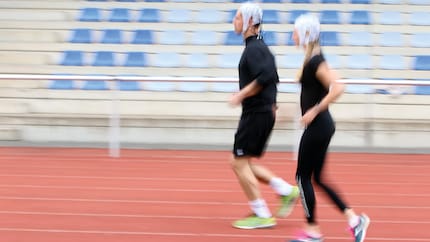
Background information
Why the 10-per-cent rule in jogging is actually wrong
by Siri Schubert

Where does the good feeling you get after a run come from? It’s not just sports scientists like Leonard Braunsmann who are interested in what happens inside the brain while jogging. Here’s our chat about mental chaos, the blessing of self-determination and the long-neglected topic of «neuronal noise».
Obviously, I take the stairs on my way to see Leonard Braunsmann. As I climb to the fourth floor, my pulse does likewise, my breathing gets faster and I go over the questions I have for him in my head. He’s a research associate at the Institute for Movement and Neuroscience of the German Sport University Cologne who conducted a study that interests me alongside Dr Vera Abeln: the «ClearMind» project is about whether and how running reduces chaos in the mind. It’s a feeling you’re probably familiar with. For me, it’s the reason why I never get in a lift before exams or interviews. I want to be on the move until the very last minute, if possible, so I can organise my thoughts. Now I’d like to learn more about the neuroscientific causes for this feeling. Right, I’ve reached the fourth floor. Now to breathe deeply three times, then ask my questions.
Hi, Leonard. Have you been for a run today?
Leonard Braunsmann: Not today, no (laughs). I actually don’t go running much. I prefer to ride my racing bike.
Well, that’s good too. Cyclists are the darlings of performance diagnostics. Is the same true of brain research?
That is actually true when it comes to the brain. When cycling, you can sit steady on the ergometer and not move your head too much. Running movements, however, can lead to interference signals when measuring brain activity. This makes measuring more difficult during physical activity, which is another reason why cycling is so popular in research.

Interference signal is a good way of putting it. For the «ClearMind» study, you took EEG measurements before and after running, i.e. measured brain waves. The focus was «neuronal noise», which I think is a great term. It immediately conjures up the image of confusion in your head. What’s the neuroscience behind it?
Neuronal noise provides information about how nerve cells in the brain communicate. For almost 100 years, only the oscillations have been examined. These are the regular oscillations of neuron activity. People only got around to studying non-oscillatory activity a few years ago. This is background noise that lies «below» the oscillations, long thought to be an interference signal and filtered out as a result.
Why is this suddenly interesting now?
We now know that it has functional relevance. For example, it correlates with age. The older you get, the more noise there is. There is also an association with some areas of cognitive performance. These insights have given it more meaning, but how this activity changes after exercising has never been investigated. Since there is little consistency in terms of studies on this topic with regard to oscillations, i.e. there are different results, we wanted to examine this «new» parameter.
We all know that great feeling and clear head after running. At least I hope so. What exactly do you want to find out about it?
The aim is to gain a better understanding of the neurophysiological mechanisms. Which processes in the brain are responsible for making us feel better after running? To find out, we wanted to consciously influence the wellbeing of the participants on one of two runs. The first time we told them they could run as much as they liked for 30 minutes…
Nice!
Yes, but four weeks later, on the second run, we set guidelines and gave instructions to influence wellbeing and their experience of autonomy. What the participants didn’t know, however, was that the aim was to match the exact speed that they had run the first time. We used EEG measurements to investigate how this affects brain activity. In addition, wellbeing was determined using questionnaires and cognitive performance was recorded using tests. We examined each of these three elements both before and after runs.

What did you find out about neuronal noise?
After both runs, we noticed that the noise was reduced. This can be interpreted as cortical deactivation, meaning the brain shutting down in a way, which has already been established from the oscillations in the alpha and beta bands. Now we have been able to back that up with non-oscillatory activity. It’s interesting that there’s a neurophysiological difference between running under someone else’s direction and running independently.
Now I’m curious.
We used two parameters – they’re called offset and slope – and we had two measurement points after the run: one at five minutes and one 25 minutes later. If you compare what happens between these two measurements, you only see changes after the externally controlled run, where activity has increased in one of the parameters and decreased in the other. In contrast, when it comes to the self-determined run, both parameters were constantly reduced, so the effects were more stable. It’s an interesting difference, because it means that the brain reacts differently when there are specifications. It seems to have to work harder, and that also has aftereffects.
I can understand that. When I go running, I don’t follow a training plan. Nevertheless, I’m driven by a certain ambition, which I always analyse at a very specific point. I tell Leonard about my running route and this tree I pass just before I first get over the mountain. It doesn’t constrain me. On the contrary in fact. Just like Leonard does with his participants, it checks to see how I’m doing. I enjoy it every time and take a moment to reflect. Is everything OK? Until now, I’ve been convinced that I was autonomous on the road. Now I’m wondering if that’s actually true.

I can identify with the group of runners in your study. They weren’t competitive athletes; they were people who run for health reasons. Like many of us, I seem to do this autonomously. But my smartwatch vibrates when I’ve run a kilometre and I react to the notification. Doesn’t that mean that I’m always subject to some external influence?
Good point. Basically, we have found that running under guidelines also has a positive effect on a psychological level, so wellbeing and cognition. We saw improvements on both runs, but when our participants ran independently, the improvements were sometimes more pronounced. This indicates that autonomy seems to have an effect.
So should we ditch our smartwatches?
Well, they can also contribute to motivation. And tracking runs can also be interesting for amateur runners. But if you’re purely concerned with the psychological effects – meaning you just want to clear your head – it may be more helpful to put down the watch and just go at your own pace.
I’ll start doing that again. Which areas of the brain react particularly strongly to running?
In the non-oscillatory brain activity we examined, the effects were evident across the entire cortex. However, there are also studies – including ones from our working group – which conclude that the prefrontal cortex is particularly affected. This area is associated with emotions or cognitive processes, among other things, which would explain why you feel better and perform better after running. But results also vary. In contrast, in the «ClearMind» study, we found that the brain shuts down everywhere with no specificity. However, this also seems to be a special property of aperiodic activity and could indicate that the brain as a whole works more efficiently and synchronously after running.
I’m on the trail of the mysteries of running. It’s our natural mode of transportation and something we’ve been doing for a few million years longer than, say, cycling. Does it have a stronger effect than other sports?
Generally speaking, it seems that aerobic sports, i.e. endurance sports, have stronger effects on brain activity. They are less pronounced in strength training, for example. In previous studies, we have found that a preferred sport or habits also seem to play a role. Which reactions show up psychologically and in the brain also depend on what you like to do or what you do regularly. Running seems to achieve this effect particularly widely.

Do you have to train to be able to experience this effect?
People just starting out in the sport show changes in brain activity, but so do ambitious triathletes. And there are studies, for example involving older people, which show that even walking has an effect on brain activity. Therefore, this effect seems to persist from young to old and from novice to pro. The main thing is to get outside and move.
At the start of our chat, you said that neuronal noise increases with age. What conclusions can be drawn from this?
Because the parameter has only recently been investigated, the question of long-term effects is still open. This is an approach that could be explored further, looking at whether it is possible to reduce the increased noise in old age through training intervention, which may then also have long-term positive effects on cognitive performance.
My head is regularly filled with noise. Should desk workers like me just be sent to run for 30 minutes every now and then, and how long do the positive effects last? Asking for a boss…
Yes, that wouldn’t just be advisable from a psychological and neuroscientific point of view. It doesn’t matter whether it’s running or walking. Half an hour later, we were still able to measure the effect. This is a time window quoted in many studies, but sometimes longer and much shorter periods of time are mentioned. There is also no clear evidence about how long the positive effects on cognition last. In the long term, we already know from longitudinal studies that higher levels of physical activity are positively correlated with many areas of physical and mental health.
I firmly believe that it’s indisputable that running not only gets your legs going, but also your mind.
Actually, the brain shuts down in a certain way, or the neurons communicate with each other in a more orderly manner. In this context, it is interesting that our participants felt more active after both runs. When neuronal noise decreases, we may no longer be paralysed by all our thoughts. Our heads are clear again.

Header image: © DSHS
Simple writer and dad of two who likes to be on the move, wading through everyday family life. Juggling several balls, I'll occasionally drop one. It could be a ball, or a remark. Or both.
Interesting facts about products, behind-the-scenes looks at manufacturers and deep-dives on interesting people.
Show all